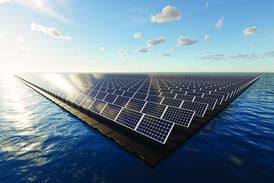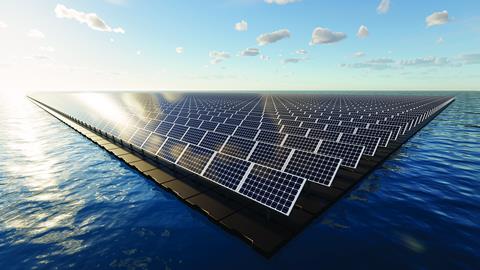The government’s Solar Roadmap envisages trebling solar electricity generation capacity in the next five years. It also proposes fundamental changes to planning law, underpinned by £46m of investment
At first glance, the idea is both brilliant and blindingly obvious. Instead of cluttering up the countryside with solar panels, why not site them on otherwise unused surfaces of lakes and reservoirs?
So-called ‘floatovoltaic’ power stations have already been built in Japan and the US. They are among the options outlined this week in the UK government’s plans to treble solar electricity generation capacity in the next five years. ‘Covering drinking water (and other man-made) reservoirs can reduce evaporation and growth of problematic algal species that will be exacerbated in a changing climate,’ the government’s Solar Roadmap enthuses.
Alas, there are complications. Although solar is probably the quickest option for adding badly needed zero carbon emission electrical generating capacity, achieving the roadmap’s goal of 45 gigawatts by 2030 will require big changes to planning law as well as technical innovation.
'More solar projects will be decided at a local level, allowing more mid-sized projects to move through the local planning system, potentially resulting in faster decisions, and at a lower cost'
Publishing the roadmap, energy and net zero minister Ed Miliband cited ‘barriers of planning, grid, supply chains and skills’.
On planning, the government aims to speed up decisions by making more decisions at a local level. An updated National Planning Policy Framework directs decision-makers ‘to give significant weight to the benefits associated with renewable and low carbon energy generation’. Meanwhile, the threshold at which solar projects enter the Nationally Significant Infrastructure Planning (NSIP) regime will rise from 50 megawatts to 100 megawatts from 31 December. ‘This will mean that more solar projects will be decided at a local level, allowing more mid-sized projects to move through the local planning system, potentially resulting in faster decisions, and at a lower cost,’ the roadmap states.
Another promised change is to replace current systems of environmental assessment with environmental outcomes reports for ‘a more effective and outcome-focused tool for managing the effects of development on the natural environment’.
A £46m package of investment in the planning system will ‘support capacity and capability in local planning authorities’. This will pay for the recruitment and training of 300 graduate and apprentice planners.
Meanwhile, a measure in the upcoming Planning and Infrastructure Bill will enable local planning authorities to set their own fees to cover the costs of their planning service, allowing them to invest more in providing them. The government is also proposing to draw up secondary legislation to enable cost recovery for relevant services provided by local authorities in relation to NSIP applications.
Another essential change is to ensure that domestic rooftop solar panels are seen as an asset rather than a liability for homeowners. According to the roadmap: ‘Government and industry will work with the Royal Institution of Chartered Surveyors to ensure that solar is valued properly on residential properties.’
Other issues needing to be tackled to achieve the 45-gigawatt ambition include urgent upgrades to the grid – both the 400-kilovolt ‘supergrid’ and local distribution power lines. Currently, local 132kV overhead wood pole lines of more than 2 kilometres have to go through the NSIP planning process, despite what the roadmap describes as their ‘low visual impact’.
Elsewhere, the roadmap covers issues ranging from the need for a ‘balanced intellectual property framework’ to encourage R&D to the alleged presence of modern slavery in supply chains. (China’s Xinjiang province produces between a third and one-half of the world’s solar-grade polysilicon; ironically this industry relies on coal-fired power stations.)
By 2030, according to the roadmap, solar panels could take up 0.4% of UK land: four times as much as today. Hence the interest in floating panels. However, these will push up hardware costs and require another set of planning reforms. Today, water companies wishing to install floating solar are exempt if using the electricity generated themselves as part of their statutory duties, but all other cases require a planning application. Utilities can expect robust opposition from anglers and recreational boaters.
According to the government, following the roadmap will provide capacity to power 9 million homes – at least during the daytime.
What it does not tackle is the fundamental problem posed by the law of physics: even with the past two decades’ improvements in efficiency, a solar power station has a capacity of about 100 watts per square metre. This is better than a wind farm (about 3 watts per square metre of land) but one-tenth of the energy density of a nuclear plant. The single plant currently under construction at Hinkley Point will have a capacity of 3.2 GW. That is an awful lot of solar-panelled duck ponds.




































No comments yet